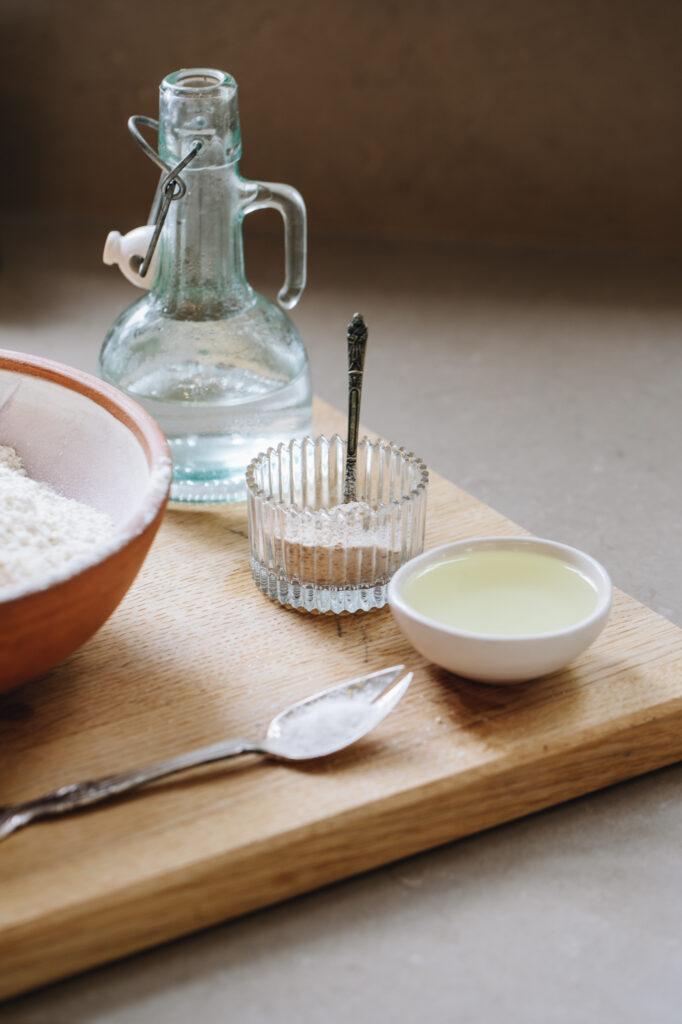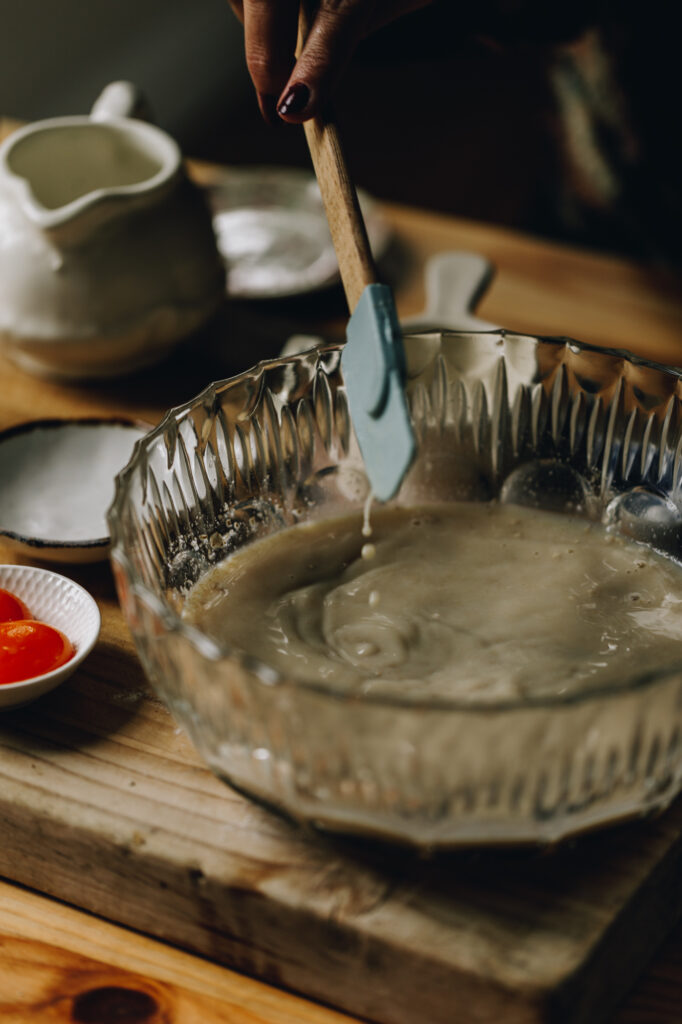
No-knead Bread Loaf – Rohi Parāoa Kore-Poke
Do you want to make a loaf of bread and not have to knead it? Yeah you do! Follow me e hoa mā (friends) as I walk you through the process of making my no-knead bread. In this post I show you the steps to bake it in a loaf tin or if you like a rustic loaf you can bake it in a cast iron pot. With only five ingredients this loaf will be the one you turn to for all your bread needs.
What if I want to make the dough today and bake it tomorrow?
You are in luck as I have given you two options for this recipe. One is to make the loaf the same day and the second option is an overnight dough that you bake the next day. Please note, the overnight loaf will have a slightly lower rise than the same day one. It still makes a delicious loaf though so do not fear! Follow along with the timings I have stated and you will be away laughing.
What is stretch and folding?
Stretch and folding is an alternative method to kneading that means you can work the dough without taking it out of the bowl. It is most often used with sourdough making. We pull it high in the air and fold it back in to the centre of the bowl, turn the bowl a quarter turn and repeat. The repetition of this motion creates gluten strands which gives us a lovely, stretchy dough. The dough is slightly wetter when we use this technique but do not add more flour, just trust the process. The video below has a more in-depth look at stretch and folding.
Can I replace the honey with other sweeteners?
Karawhuia – go for it. When I make this dough, I just use whatever I have on hand. You can replace the mīere (honey) with marahihi māpere (maple syrup), mīere koura (golden syrup) or any sugars such as huka one (caster sugar) or huka hāura (brown sugar).
Can I add extra things in to the bread?
Of course you can, adding a third of a cup of chia, sunflower or pumpkin seeds would be so delicious in this loaf. If you are adding seeds, add them in the second round of stretch and folding. Be careful if you are changing the flours though as wholemeal and other higher fibre flours absorb a lot more liquid so it can throw off the balance. I will attempt a no-knead wholemeal loaf in the not to distant future.







No-knead Bread Loaf – Rohi Parāoa Kore-Poke (Same Day and Overnight Version)
Ingredients
The Dough – Te Pokenga
- 2 C (500 ml) wai aromahana (lukewarm water)
- 2 tbsp mīere (honey, you can also swap this maple syrup or any type of sugar)
- 1 sachet īhi tere (instant yeast, 7g) OR 16 g (2 tbsp) Surebake/breadmakers yeast. (Note: I prefer instant yeast for this recipe, use surebake as the last resort).
- 3 ¾ C (550 g) puehu parāoa kounga (high grade flour)
- 2 tsp tote (salt, fine)
Instructions
The Dough – Te Pokenga
- Add the wai (water) and mīere (honey) in to a large bowl. Stir it until the mīere (honey) is dissolved. Sprinkle over the īhi tere (instant yeast), stir again and leave until foamy for 5 minutes.
- Add the puehu parāoa (flour) and the tote (salt). Stir it all together with a bread knife for 1-2 minutes until combined. It will be sticky, don't add any more flour.
- Cover the bowl with a bowl cover or tea towel. Leave to rise for 30 minutes.
- After 30 minutes, it is time to stretch and fold the dough. With wet hands, take a handful of dough from the side of the bowl, pull it high in the air (see video for reference) and then place it in to the centre of the bowl.
- Turn the bowl a quarter turn and repeat that process. Every time you place the dough in to the centre it is one count. In total do 26-30 stretch and folds. This should take 1-2 minutes.
- Cover the bowl again and leave for 30 minutes. Repeat the stretch and fold process. This time do 18-22 stretch and folds.
Same Day Version
- After you have completed the second round of stretch and folds, cover the bowl and allow the dough to rise again for 15 minutes.
- Grease your bread tin with neutral oil. Mine is 22cm long x 11cm wide and 10cm high. If you are using a tin that is similar size but not as high, it maybe better to split the dough between two tins.
- Tip the dough on a very lightly floured bench. Don't handle the dough too much here.
- Fold the dough in to the centre from the top and each side. Then take the bottom piece and flip it forward, over the dough. Tuck your hands underneath the dough and pull it towards yourself a couple of times.
- Gently lower the dough in to the loaf tin, seam side down. Cover with a tea towel and allow to rise for 25-30 minutes or until it has doubled in size.
- Pre-heat the oven to 180 °C on fan bake, 15 minutes before baking. Dust the loaf with a little flour or fine semolina. Score it down the middle.
- Bake for 45 minutes. Cool on a baking tray for 5 minutes and devour.
Overnight Version
- After you have completed the second stretch and fold process, cover the bowl and leave on the bench for 15 minutes. Then refrigerate for 2 – 24 hours.
- When you are ready to bake, remove the dough from the fridge. Tip it straight on to a bench with no flour.
- Fold the dough in to the centre from the top and each side. Then take the bottom piece and flip it forward, over the dough. Tuck your hands underneath the dough and pull it towards yourself a couple of times.
- Lower the dough in to a greased loaf tin, seam side down. Cover with a tea towel to rise.
- If the dough has risen in the fridge for 2-6 hours, rise the dough for 1 hour. If it has risen for 7-12 hours, rise the dough for 1 hour and 15 minutes.If it has risen for 13 – 18 hours, rise for 1 hour and 30 minutes.If it has risen for 19 – 24 hours, rise for 1 hour and 45 minutes – 2 hours.The main thing to look for during the second rising process is if the dough has doubled in size. Sometimes it can take 10 minutes less, other times it takes 10 minutes longer.
- Pre-heat the oven to 180 °C on fan bake 15 minutes before baking.Dust the loaf with a little flour or fine semolina. Score it down the middle.
- Bake for 50 minutes until golden. Cool on a baking tray for 5 minutes and devour.


Beautiful bread. I’ve given up on tasteless breadmaker bread and was looking for a new recipe. It was quite therapeutic going back to handling the dough. Beautiful flavored, soft chewy bread . A new favorite recipe. Thank you.
Lynne, this makes me so happy. I am also making this recipe as I write this reply to you. I am so glad you like it and I love that you come back to the dough and spend a minute or so reminding it what to do and it just quietly obeys.
I’ve been making this bread with my kids, and it’s such a beautiful loaf! I like the over night version best, it’s less sticky to work with when rolling it up for the loaf tin. At least that’s how it behaves at my house! It’s proven to be a pretty robust recipe, the last time I made it I used a 50:50 mix of whole meal and pasta flour (of all things!). It was all I had to hand. The loaf was a bit more dense, but still soft and chewy and delicious! Thanks for sharing the recipe!
Kia ora Kristi, this is so cool to hear. This is a very popular recipe in our whare (house) too and mixing the flours to see what happens, is all part of the joy isn’t it.
How awesome to read this. Thanks so much for this awesome review!
I tried this recipe today. Followed step by step and everything went as it should, until it was time to put it on a lightly covered counter. Your dough seems a little bit firmer than mine. I couldn’t fold it like you did in the video as it wasn’t as firm. Must add, it’s cold and rainy here in Christchurch, so that could be part of my problem. Dough rose perfectly as i put it in warm oven to rise. Anyway, i still put it in bread tin and it’s rising now. Hoping I still get a good bread out of it.
Oh how did it go in the end?
I’ve been making a no knead bread in a cast iron and wanted to try a sandwich loaf pan and came across this recipe. I followed the stretch and folds and folding before placing into the loaf pan and had the best no knead bread success since I started. I’ll go back and make this recipe and had to say your techniques were easy to follow and encouraged me to try more no knead recipes. Thank you!!!
Kia ora Rachal, I am so glad that you tried this recipe. It is defiantly a go to in our whānau too.
Thank you for the wonderful feedback.
Easy recipe to make and fun to stretch and fold, final mixture was very sticky and hard to mould into the tin so I just plonked it in and it cooked up fine. My tin was 8cm high so it had a big muffin top but was fine.
Will definitely make again, delicious.
The CHO factor for other diabetes families is 0.45
Oh cool Kelly, yes it totally is a sticky dough but seems to work itself out eventually aye. So glad you and your whānau enjoyed it. Ngā mihi, Naomi